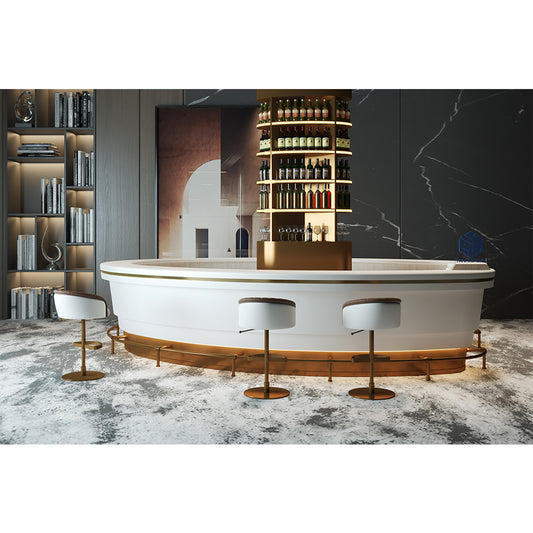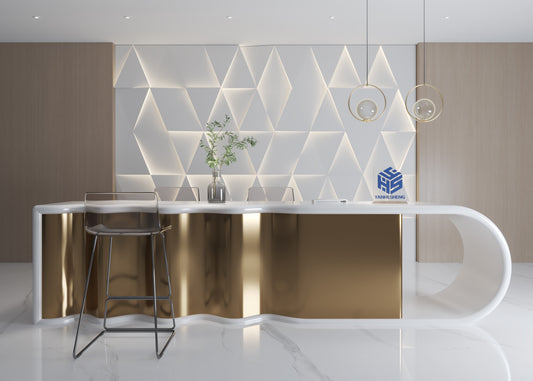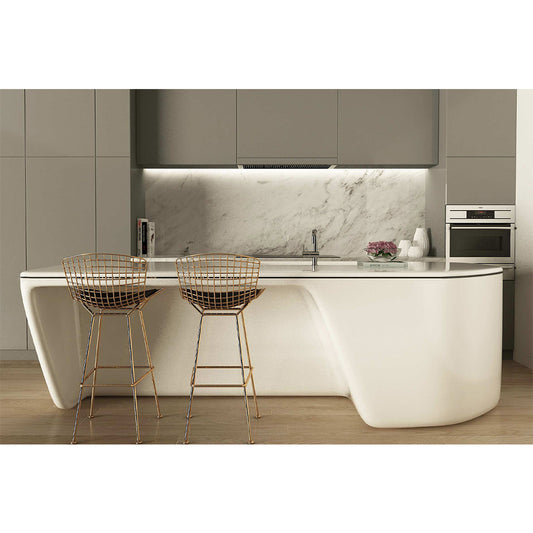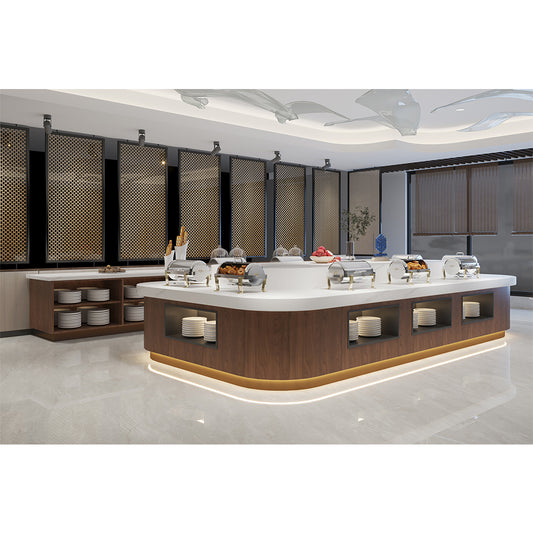Designing a modern, simple white fashion creative three-legged hospital reception desk combines both functional and aesthetic considerations to enhance the overall ambiance of a hospital or clinic. This design can introduce an innovative touch to healthcare environments while maintaining the clean, minimalist look necessary for such spaces.
Below is an in-depth exploration of how this design could be implemented using solid surface materials, with a focus on both practicality and creativity.
1. The Concept: Modern, Simple, and Creative

A three-legged reception desk stands out as a bold, creative choice for hospital spaces. Modern healthcare environments are evolving to focus more on patient experience, and incorporating innovative design elements like this helps create a welcoming, stress-free atmosphere.
Key elements of this design concept:
- Minimalist Structure: Keeping the desk free from excessive ornamentation aligns with the simplicity and functionality of modern minimalism.
- White as a Dominant Color: White embodies cleanliness, which is essential in healthcare facilities, and gives a bright, open, and hygienic feel.
- Creative Yet Functional Design: The unique three-legged structure offers a touch of creativity, making the desk a focal point while ensuring it's practical for daily use in a busy hospital environment.
2. The Role of Solid Surface Materials

Solid surface materials, such as those provided by YHS (Yenstone), are perfect for designing custom reception desks, especially for healthcare facilities where hygiene and durability are paramount.
Why Solid Surface Materials?
- Non-Porous and Hygienic: Solid surfaces are non-porous, meaning they don’t harbor bacteria or germs, a crucial feature in healthcare settings.
- Durable and Scratch-Resistant: Solid surface materials can withstand heavy use, making them ideal for hospital reception desks that see high traffic.
- Seamless Design: Solid surfaces can be molded to create a seamless look, ensuring no cracks or gaps where dirt or bacteria could accumulate.
For a three-legged desk, solid surface material offers the flexibility needed to craft a unique yet functional design. It can be molded into custom shapes, including the legs and tabletop, ensuring the desk is both aesthetically striking and durable.
3. Design Features of the Three-Legged Reception Desk
3.1. Minimalist, Seamless Surface
The desk’s body can be designed as a single, seamless unit made from solid surface material, providing an ultra-clean and modern look. The seamless nature of the material also eliminates joints, making it easy to clean and maintain — a crucial aspect in hospitals.
3.2. Creative Three-Legged Structure
The three-legged design can be interpreted in several ways:
- Triangular Base: The desk can rest on three large, sturdy legs, perhaps made from solid surface material, giving it a futuristic, sculptural appearance.
- Central Support with Two Front Legs: This approach balances the need for stability and style. The central support could be hidden to give the illusion of "floating," while the front two legs maintain an elegant appearance.
- Abstract or Geometric Legs: For a more avant-garde look, the three legs could be designed in an abstract or geometric style, offering a striking visual element that immediately catches the eye.
3.3. Integrated Features for Functionality
Despite its creative design, the desk must retain practical features:
- Built-in Storage: Drawers or shelves can be discreetly integrated into the desk’s body, allowing hospital staff to have easy access to essential materials while keeping the surface uncluttered.
- Wire Management: Integrated wire management channels can keep cables and electronic devices organized and out of sight, enhancing the minimalist aesthetic.
4. Functionality Meets Design: Practical Use in Hospitals

While the design of a three-legged reception desk is visually interesting, it must also meet the rigorous demands of hospital use. Here are some ways to ensure it performs well in a healthcare environment:
4.1. Ergonomics and Comfort
Reception desks in hospitals are used for long periods, so it's important to ensure that they are ergonomic:
- Height Consideration: The desk should be designed at a height that is comfortable for both patients and staff, usually around 42-45 inches.
- Spacious Countertop: The top surface should provide enough space for computers, paperwork, and any other materials needed by the reception staff without appearing cluttered.
4.2. Durability in High-Traffic Areas
Since hospital reception desks experience high foot traffic, the desk must be durable. Solid surface materials provide excellent durability, resisting stains, scratches, and impacts — crucial in a busy hospital setting. YHS’s solid surface materials are particularly well-suited for such environments.
4.3. Hygiene and Cleanliness
Hospitals require the highest hygiene standards. Solid surfaces’ non-porous nature prevents the growth of bacteria and ensures easy cleaning. Seamless joints and corners make it easy to sanitize the desk frequently without missing hard-to-reach areas.
5. Customization Options with YHS Solid Surface Materials
With YHS, hospitals can fully customize their reception desks to suit their unique needs and branding. Here are some ways to tailor the design:
5.1. Color and Finish
- White Gloss or Matte Finish: The reception desk can be crafted in a sleek, glossy white finish for a modern and high-end look, or a matte finish for a softer, more understated luxury feel.
- Textured Surfaces: For added visual interest, textured finishes can be applied to parts of the desk, such as the legs, to contrast with the smooth top.
5.2. Custom Edges and Details
- Rounded Edges: To enhance safety and avoid sharp corners, rounded edges can be used, especially on the countertop where patients and staff frequently interact.
- Engraved Logos or Signage: Hospital logos or welcome messages can be engraved into the solid surface material, adding a personalized touch to the reception area.
5.3. Lighting Integration
- LED Underglow Lighting: Integrating subtle LED lighting underneath the desk or around the legs can enhance the luxury feel while providing practical illumination for night shifts.
- Embedded Task Lighting: For staff convenience, task lighting can be embedded into the desk’s surface to ensure adequate lighting for documentation and patient interactions.
6. Advantages of Choosing YHS for Your Three-Legged Reception Desk

By choosing YHS solid surface materials, hospitals gain several advantages:
- Custom Design: YHS offers full customization, allowing healthcare facilities to create reception desks that match their design aesthetics and practical needs.
- Durability: YHS materials are built to last, ensuring that your hospital reception desk remains in pristine condition despite daily use.
- Hygiene: Non-porous and seamless, YHS solid surfaces are easy to clean and maintain, meeting the high sanitation standards required in healthcare facilities.
- Sleek and Modern: The materials are perfect for achieving the minimalist, modern aesthetic that many hospitals are moving toward, enhancing patient and visitor experiences.
7. Conclusion: Modern Simplicity with a Creative Twist
A modern, simple white fashion creative three-legged hospital reception desk is the perfect solution for hospitals looking to create an inviting yet professional reception area. By using YHS’s solid surface materials, this design can blend creativity with practicality, offering a stunning visual centerpiece that also meets the high demands of a healthcare environment.
With custom features like seamless design, ergonomic comfort, and integrated functionality, this desk can redefine how patients and visitors perceive the hospital's reception area, providing both a welcoming atmosphere and an efficient workspace.





